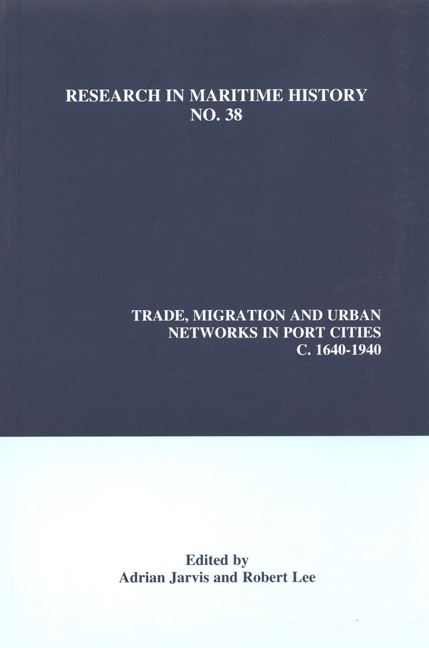Book contents
- Frontmatter
- Table of Contents
- Contributors' Notes
- “Trade, Migration and Urban Networks, c. 1640-1940: An Introduction”
- “Portuguese Jews in Amsterdam: An Insight on Entrepreneurial Behaviour in the Dutch Republic”
- “Contrasting Merchant Communities in the Early Eighteenth Century: Stockholm, Calabar and Charleston”
- “Integration of Immigrant Merchants in Trondheim in the Seventeenth and Eighteenth Centuries
- “In the Eye of the Storm: The Influence of Maritime and Trade Networks on the Development of Ostend and Vice Versa during the Eighteenth Century”
- “Exploiting International Webs of Relations: Immigrants and the Reopening of the Harbour of Antwerp on the Eve of the Nineteenth Century”
- “Migrants, Merchants and Philanthropists: Hierarchies in Nineteenth-Century Greek Ports”
- “Port Cities, Diaspora Communities and Emerging Nationalism in the Ottoman Empire: Balkan Merchants in Odessa and Their Network in the Early Nineteenth Century”
- “Combining Business and Pleasure? Cotton Brokers in the Liverpool Business Community in the Late Nineteenth Century”
“Contrasting Merchant Communities in the Early Eighteenth Century: Stockholm, Calabar and Charleston”
- Frontmatter
- Table of Contents
- Contributors' Notes
- “Trade, Migration and Urban Networks, c. 1640-1940: An Introduction”
- “Portuguese Jews in Amsterdam: An Insight on Entrepreneurial Behaviour in the Dutch Republic”
- “Contrasting Merchant Communities in the Early Eighteenth Century: Stockholm, Calabar and Charleston”
- “Integration of Immigrant Merchants in Trondheim in the Seventeenth and Eighteenth Centuries
- “In the Eye of the Storm: The Influence of Maritime and Trade Networks on the Development of Ostend and Vice Versa during the Eighteenth Century”
- “Exploiting International Webs of Relations: Immigrants and the Reopening of the Harbour of Antwerp on the Eve of the Nineteenth Century”
- “Migrants, Merchants and Philanthropists: Hierarchies in Nineteenth-Century Greek Ports”
- “Port Cities, Diaspora Communities and Emerging Nationalism in the Ottoman Empire: Balkan Merchants in Odessa and Their Network in the Early Nineteenth Century”
- “Combining Business and Pleasure? Cotton Brokers in the Liverpool Business Community in the Late Nineteenth Century”
Summary
This essay examines the nature of merchant communities and the trades they conducted in three eighteenth-century ports: one in the Baltic, one on the Bight of Biafra and one in British North America. These were three apparently disparate ports, but in the early eighteenth century they were brought together in a trading network centred on a fourth – Bristol. The empirical foundation for what follows is the amply documented activity of a Bristol merchant named Graffin Prankard. Prankard (d. 1756) was part of a Quaker trading network in the English West Country. He settled in Bristol in the first decade of the eighteenth century and soon distinguished himself in the city's Atlantic trade. At the height of his powers in the 1730s he was Bristol's leading iron merchant. International commerce was a volatile environment, however, and Prankard became insolvent in 1740. He was bailed out by his son-in-law, Caleb Dickinson, a wealthy Somerset landowner. For that reason, many of Prankard's accounts and letter books, which might otherwise have gone the way of most business records of the period, have been preserved in the estate archive of the Dickinson family.
In the 1720s and the 1730s Prankard began to put together an innovative web of commercial exchanges that brought together the Baltic and Atlantic worlds. Swedish bar iron was imported from Stockholm and then exported to West Africa and South Carolina, either in bar form or embodied in manufactured goods that had been wrought in Bristol's hinterland. We will use the cat's cradle of commodity exchanges that Prankard orchestrated to illuminate mercantile enterprise in each of the ports concerned. Three particular aspects of port life will be highlighted: the role of the state in regulating trade, the importance of ethnic affinity within the merchant class and the relationship of urban merchants to production in the hinterlands of their respective ports.
Stockholm
Stockholm was by far the largest of the port cities under consideration. With 70,000 inhabitants in the mid-eighteenth century, it stood alone at the head of Sweden's urban hierarchy, with Karlskrona, the southern naval base, a distant second. Set at the eastern end of Mälaren, the vast lake system that defined the ancient kingdom of the Svear, Stockholm was Sweden's premier port.
- Type
- Chapter
- Information
- Publisher: Liverpool University PressPrint publication year: 2008



